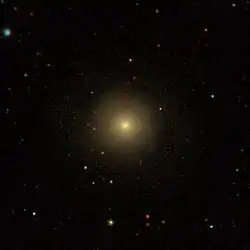NGC 3971
| NGC 3971 | |
|---|---|
 SDSS image of NGC 3971. | |
| Observation data (J2000 epoch) | |
| Constellation | Ursa Major |
| Right ascension | 11h 55m 36.4s[1] |
| Declination | 29° 59′ 45″[1] |
| Redshift | 0.022676[1] |
| Heliocentric radial velocity | 6798 km/s[1] |
| Distance | 315 Mly (96.6 Mpc)[1] |
| Apparent magnitude (V) | 13.7[1] |
| Absolute magnitude (B) | -22.06[1] |
| Characteristics | |
| Type | S0[1] |
| Size | ~97,400 ly (29.85 kpc) (estimated)[1] |
| Apparent size (V) | 1.06′ × 0.99′[1] |
| Other designations | |
| NGC 3984, UGC 06899, CGCG 157-054, PGC 037443, MCG +05-28-047[1] | |
NGC 3971 is a lenticular galaxy located 315 million light-years away[2] in the constellation Ursa Major. It was discovered on February 3, 1788, by astronomer William Herschel. It was then rediscovered by his son John Herschel on April 10, 1831 and given the duplicate designation NGC 3984.[3][4] NGC 3971 forms a pair with the galaxy UGC 6905 known as [T2015] nest 103168,[5] and is part of the Coma Supercluster.[6][7]
NGC 3971 is a LINER galaxy,[8][9] and is host to a supermassive black hole with an estimated mass of 9.6 × 108 M☉.[10]
See also
References
- ^ a b c d e f g h i j k "Results for object NGC 3971". NASA/IPAC Extragalactic Database. NASA and Caltech. Retrieved 2025-07-08.
- ^ "Your NED Search Results". ned.ipac.caltech.edu. Retrieved 2025-07-08.
- ^ "New General Catalog Objects: NGC 3950 - 3999". cseligman.com. Retrieved 2025-07-08.
- ^ "Notes on the NGC objects, particularly those missing, misidentified, or otherwise unusual (ngcnotes.all)". Historically-aware NGC/IC Positions and Notes. Retrieved 2019-08-11.
- ^ Tully, R. Brent (2015-04-28). "Galaxy Groups: A 2Mass Catalog". The Astronomical Journal. 149 (5): 171. arXiv:1503.03134. Bibcode:2015AJ....149..171T. doi:10.1088/0004-6256/149/5/171. ISSN 1538-3881.
- ^ Gregory, S. A.; Thompson, L. A. (1978-06-15). "The Coma/A1367 supercluster and its environs". The Astrophysical Journal. 222: 784. Bibcode:1978ApJ...222..784G. doi:10.1086/156198. ISSN 0004-637X.
- ^ Perea, J.; Moles, M.; del Olmo, A. (April 1986). "Taxonomical analysis of superclusters - II. The A 1367/Coma supercluster". Monthly Notices of the Royal Astronomical Society. 219 (3): 511–524. Bibcode:1986MNRAS.219..511P. doi:10.1093/mnras/219.3.511. ISSN 0035-8711.
- ^ Capetti, A.; Brienza, M.; Balmaverde, B.; Best, P. N.; Baldi, R. D.; Drabent, A.; Gürkan, G.; Rottgering, H. J. A.; Tasse, C.; Webster, B. (April 2022). "The LOFAR view of giant, early-type galaxies: Radio emission from active nuclei and star formation". Astronomy and Astrophysics. 660: A93. arXiv:2202.08593. Bibcode:2022A&A...660A..93C. doi:10.1051/0004-6361/202142911. ISSN 0004-6361.
- ^ "NGC 3971". simbad.u-strasbg.fr. Retrieved 2025-07-08.
- ^ Arzoumanian, Zaven; Baker, Paul T.; Brazier, Adam; Brook, Paul R.; Burke-Spolaor, Sarah; Becsy, Bence; Charisi, Maria; Chatterjee, Shami; Cordes, James M.; Cornish, Neil J.; Crawford, Fronefield; Cromartie, H. Thankful; Decesar, Megan E.; Demorest, Paul B.; Dolch, Timothy (2021-06-01). "The NANOGrav 11 yr Data Set: Limits on Supermassive Black Hole Binaries in Galaxies within 500 Mpc". The Astrophysical Journal. 914 (2): 121. arXiv:2101.02716. Bibcode:2021ApJ...914..121A. doi:10.3847/1538-4357/abfcd3. ISSN 0004-637X.